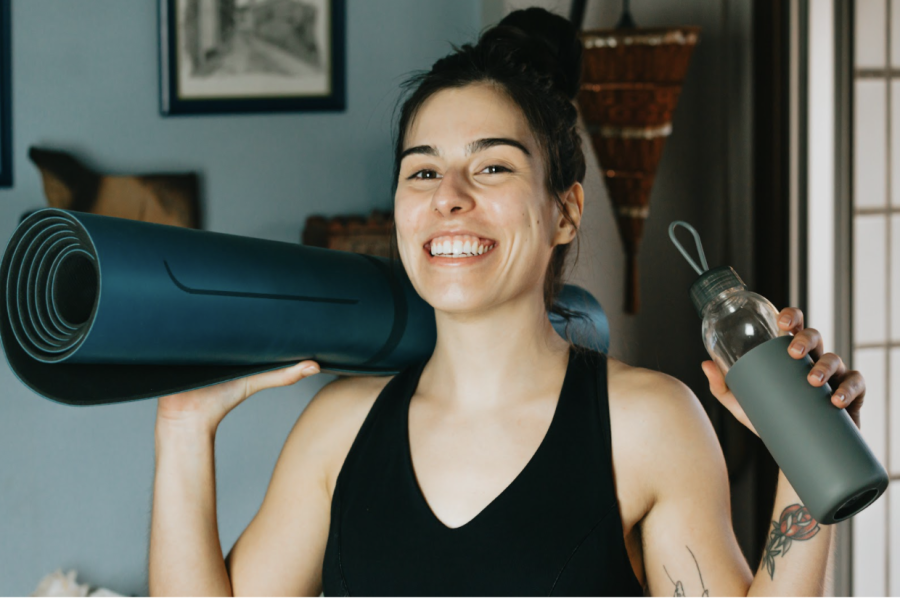Strength-training in a Pandemic: Activity for Your Longevity
February 2, 2022
You and I can likely attest to how a global pandemic, in addition to quarantine, has led to a more sedentary lifestyle and a lot more back pain. We’re not alone. A survey conducted by OnePoll found that 74% of Americans have been sitting for longer periods of time since March 2020, and three in five Americans have experienced new backside aches and pains due to inactivity. Considering how the state of our orthopedic health (bones, joints, muscles, etc) is maintained and strengthened by external stressors, strength training is the solution to helping you decrease your back pain (which is due to weak hip and core muscles), and perform tasks like carrying grocery bags and standing up from a chair without hearing a crack.
WAIT. Before you imagine lifting the 100 lb weights or using the intimidating equipment at a gym, you should know that strength training is simply doing activities that make your muscles stronger. To be more specific, think of it as resistance training: exercising a muscle or a muscle group against external resistance. There is a wide spectrum of resistance that you can add, not just holding dumbbells while doing bicep curls. During a pandemic (or any other time), using your bodyweight, a milk carton, or a backpack with a textbook is more than enough to get the blood flowing.
Now how does this “external” resistance help keep you internally healthy? Well, our bodies abide by the second law of thermodynamics, which states that every single thing in the universe is moving from “having order towards a state of chaos and disorganization,” Jared De Candia, certified personal trainer (CTP), explained to me in an interview. However, our body does not have a system to regulate our orthopedic health, so we “have to put in the work to make sure that they don’t become disorganized,” Candia says. Otherwise, on a microscopic level, our body becomes weaker each day; this process speeds up when we reach our 30’s. To prevent entropy, strength training is a way to healthily tear our muscles. When we properly rest and recover (eat, sleep, and hydrate!), the muscle rebuilds itself.
Ladies, you may not be fully convinced because you’re worried about looking “bulky.” (I had fallen for this too.) Rest assured, you won’t look like The Rock after lifting a couple of weights. If you were to ask the people who look muscular how they achieved this physique, they’ll tell you that they specifically train to look this way. Moreover, this level of hypertrophy requires a dedication to a diet outside the gym and years of hard work (or at least no social life) to get to that point. The misconception comes from the assumption that it’s easy to look “big” and ignorance regarding what else is involved. In the end, “for the average person to start lifting weights, you won’t look like that, if you don’t want to look like that,” said Candia, CTP.
To start working out, or incorporate more strength training into your workout routine, Candia suggests focusing on “joint actions” that make sure “your program is balanced because it guarantees that you’ll hit all the muscle groups.”
For the upper body, there are push and pull movements, which should be split into two nonconsecutive days. Push movements involve pushing something away from you, like during a pushup; your muscle tissue lengthens during this eccentric phase. These movements will work the chest, shoulders, and triceps. Pull movements contract a muscle group to pull the weight towards you; they work muscles in the back, the forearms, and the biceps. For the lower body, hip dominant movements work your glutes and hamstrings. Knee dominant movements, which involve bending the knee, work the glutes and quads. Examples include the well known squats and lunges. The overload placed on your body during strength training also leads to stronger bones, which improves one’s balance, decreasing the chances of injury. Even as a teenager, we are at the optimal phase in our life to build habits like strength training to “make sure that as you get older your bones are as healthy as they can be” (National Institute of Arthritis and Musculoskeletal and Skin Diseases).
To learn about basic movement patterns, look at online tutorials (videos, swipe-through posts) that can teach you what the proper form looks like for an exercise. Working out in front of a mirror can also help you adjust your form as needed. My favorite female fitness influencers that provide workouts and demonstrate exercises are Krissy Cela, Whitney Simmons, and Caroline Girvan.
As you progress in your journey, you want to slowly implement progressive overload. Essentially, as you build muscle, doing exercises with your bodyweight will become easier. Thus, you have to overload your muscle so that it continues to work harder than normal, stimulating further strength increases. Consider investing in a pair of dumbbells, which “are probably the most user-friendly weight option for beginners,” says Sivan Fagan, CTP, in an interview with SELF.
If you don’t have access to equipment, there are other ways to progress. An easy way to add difficulty is by slowing down the concentric part of a push exercise, like when you’re lowering yourself in a squat, or lowering in a pushup. “The slower you go there, the harder the push is going to be [back up],” Elias Kokalis says, a strength and conditioning coach. Secondly, he suggests holding a position longer, like a wall squat or plank, which is “more stress you’re adding to the body.” Lastly, adding an explosive element to an exercise where you must push harder or move faster, will require “a lot more energy to explode through and do that thing,” Kokalis explains. This can look like doing as many pushups as possible in 15 seconds or adding a jump after every two squats.
While the mental health benefits of strength training will vary for each person, anyone who works out can testify to how big of a component exercising plays for our mental health. Strength training releases endorphins, along with “chemicals like dopamine and serotonin that actually make you happy,” Candia explains. Furthermore, strength training has been beneficial for Candia to “fight stress” and “mild depression,” as he has noticed a pattern of feeling stressed when he doesn’t work out for a while.
Personally, I found strength training to be a way for me to release stress and increase my self confidence during the pandemic. Everytime I roll out my mat, play my music, tie my hair up, it signals to me that it is time to forget everything that is going on outside, and focus on this present moment, a gift to myself. It’s after using heavier weights or being able to do one more rep, when I realize that I can reject the limiting beliefs in my head. I can do hard things. It increases my mental and physical strength in a way that nothing else can.
Since March 2020, 46% of parents say their teen has shown signs of a new or worsening mental health condition, according to the C.S. Mott Children’s Hospital National Poll on Children’s Health at Michigan Medicine. A survey by the US Census Bureau in December 2020 showed a 31% increase from the previous year of adults who reported symptoms of anxiety or depression. Now more than ever, the act of physical activity is being overlooked when it can be the solution to combating the negative impact of the pandemic on our mental health. I know this because strength training played a huge factor in training me to continue when things seem impossible, especially during the winter months. It trains me to focus on the task at hand, instead of the uncontrollable future. Strength training trains us to be physically and mentally ready for all that life has to throw our way.
In order for our body to stay healthy and functional, we must use the 600 muscles that it consists of to feel good. Take the information you need from this article, whether it’s implementing two upper body strength training days, or one push day and one pull day, into your current routine. Find how strength training can be incorporated into your lifestyle, and experience the mental and physical health benefits in your day to day life.
















